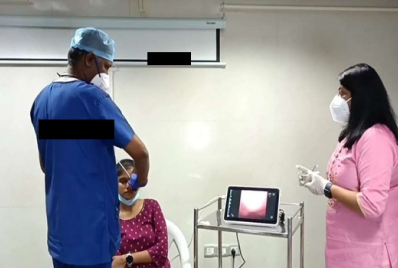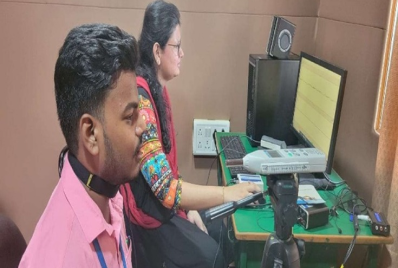Auditory Verbal Therapy
This is first and one of the best Center for re/habilitating children and adults with Cochlear Implant in
India. This unique center was established in 2000, since then this had been the referral and training
center for many teachers across the globe. Very active center with annual patient load of 150 and total
number of therapy session per year around 14,500. The quality control of the center is monitored by
experts from USA and Europe.
Auditory habilitation refers to the plan to improve the communication with younger children who have
not yet attained spoken language following hearing loss. Rehabilitation focuses on restoring a skill of
listening which was not acquired due to hearing loss. In children the skills may not be there so it has to
be taught, hence it is called habilitation.
Habilitation includes:
- Finding a way for your child to communicate
- Learning Speech and language
- Learning to listen to different sounds
- Training on how to take care of hearing aids and other amplification devices
The goal of auditory rehabilitation clinic at MERF– ISH is not only to focus on child rehabilitation but
also rehabilitation for adolescents and adults both prelingual and post lingual.
The services are
provided by specially trained and skilled auditory habiltationist who are trained under different domains
to treat children, adolescents and adults and those children with complex needs who have undergone
MERF ISH is the first center to establish satellite auditory habilitation center in India to cater
to children across the state of Tamil Nadu. MERF ISH & MERF has developed a sustainable and successful
model of re/habilitation for the developing nations; this model is well appreciated by experts all over
the world and attracted invitation to present in many international meetings, forums and recently in WHO.
Satellite centers across Tamil Nadu are located in Coimbatore, Tiruchirapally, Madurai and also
Tirunelveli, which also have experienced habilitationist’s who provide firsthand habilitation service.
All the clients are assessed by a speech-language pathologist and auditory habilitationist in one
to one sessions and all consultation are done on appointment basis.
What is auditory-verbal and auditory-based therapy?
For young children who use cochlear implants or hearing aids or who are deaf and hard of hearing, early intervention therapy is known as Auditory-verbal therapy (AVT), often called auditory-based therapy. Your child's therapist might be able to teach them how to listen and communicate verbally, even if their hearing loss ranges from severe to profound. In addition to actively participating in therapy sessions, parents and other caregivers carry out the exercises at home.Through auditory-verbal therapy (AVT), your child who is deaf or hard of hearing should be able to learn, listen, and speak with the same fluency as children who can hear. Children who receive AVT do well in traditional classroom settings. They become friends, improve their reading and math skills, develop self-worth, and lead independent lives.
Hearing aids and cochlear implants can benefit your children. However, they must still learn to interpret signals when listening to sounds.
How successful is Auditory-Verbal Therapy? Is it successful?
The most frequent congenital condition is hearing impairment, which means it was present at birth. However, just because your child has a hearing disability does not preclude them from learning to hear. These assistive devices can be helpful for kids who wear hearing aids or have cochlear implants. Generally, it achieves remarkable loudness.
According to research, many deaf and hard-of-hearing children who receive auditory-verbal therapy (AVT) by the first grade have spoken language skills comparable to or even surpassing those of their hearing peers. Studies have also shown that these children tend to perform better academically than deaf and hard-of-hearing children who do not participate in AVT.
Who is Eligible for Auditory-Verbal Therapy?
Auditory-verbal therapy (AVT) is most helpful for children as young as two to three months old. If your young child is deaf or hard of hearing and uses hearing aids or cochlear implants, auditory-verbal therapy may be beneficial. Make sure your newborn gets the Universal Newborn Hearing Screening (UNHS). If necessary, newborns can be fitted with hearing aids. If hearing aids are insufficient, your kid can be assessed for cochlear implants as young as nine months old.
It makes little difference. If your child was born hard of hearing or deaf, there may be another reason for their hearing loss. Impairment. They may benefit from auditory-verbal treatment if they have difficulty hearing out of one or both ears, if their condition is chronic or transitory, or if their hearing loss ranges from mild to severe/profound.
Participate in the treatment session with your child. Your healthcare provider will guide you along the journey. It helps if you learn in the same way they do. Then, your "job" will be to continue teaching them outside of their clinician-led lessons.
What are hearing aids? What are cochlear implants?
Hearing aids amplify sounds, including speech. However, individual hearing loss can vary, so it is possible to modify hearing aids to meet particular frequency requirements. While hearing aids make sounds louder, they don't guarantee understanding. Auditory-verbal therapy (AVT) can help children comprehend speech and other sounds more effectively.
If hearing aids are insufficient for your child, their doctor may suggest cochlear implants. The cochlea is a hollow bone located inside the inner ear. When it works properly, your inner ear converts sound waves into electrical impulses that can be interpreted. If your inner ear requires assistance, a surgeon can insert an implant into your cochlea. The device bypasses the damage and gives your child access to sound.
To participate in auditory-verbal therapy, your youngster usually needs to get cochlear implants or hearing aids fitted.
Where is auditory-verbal therapy conducted?
Although the therapist's office is a standard setting for auditory-verbal therapy, it also occurs in your home, as you are your child's first and most significant instructor. When "coaching" your child, bear the following advice in mind:
- Speak near your child's hearing aids or microphone on their cochlear implant.
- Speak as gently and naturally as possible.
- Don't speak loudly — use your regular volume.
- Remove all background noise, including fans, air conditioners, and background music or other stimuli.
- Repeat what you say as needed.
- Speak expressively and with a melodic rhythm. This can help "capture" your child auditorily.
What kind of healthcare provider provides the therapy?
Audiologists and speech-language pathologists work with deaf and hard-of-hearing children. They may also train to become listening and spoken language specialists (LSLS) who can conduct auditory-verbal therapy with expertise.
What is the difference between auditory-verbal therapy and other methods of therapy for people who are deaf or hard of hearing?
"Visual communication methods like lipreading and sign language can limit the stimulation of your child's hearing center (auditory cortex). Audio Vestibular Therapy (AVT) helps develop your child's auditory brain, improving their ability to speak and listen."
The child's caretakers are also involved in auditory-verbal treatment. Parents who care for children receive coaching on various methods and approaches to help them learn at home through play and other daily activities.
How does auditory-verbal therapy work?
Your child, their therapist, and any caregivers (parents, siblings, grandparents, etc.) participate in an auditory-verbal therapy session. Your youngster will learn how to speak and listen through encounters that happen naturally, such as:
- Talking
- Singing
- Playing games
Procedure Details
How do I prepare for auditory-verbal therapy?
Before you go for a lesson, make sure your child's cochlear implants or hearing aids are functioning correctly. As you play with your child during the day, you should also check the hearing technology.
What should I bring to the verbal-auditory treatment?
Bring paper in a notebook or three-ring binder. These will be useful for:
- Writing down or drawing ideas for activities to do with your child at home.
- Recording goals.
- Noting your child's progress.
A scrapbook or photo album, either digital or analog, would also be desirable to capture images that demonstrate your child's development and write a note describing what you saw.
What is the duration of auditory-verbal therapy?
The curriculum typically lasts three years or longer. You and your child must attend the sessions regularly. It is also important to continue working with your child outside of sessions.
Risks / Benefits
What are the advantages of Auditory-Verbal Therapy?
Auditory-verbal therapy allows your child to participate in "mainstream" society. They can have the same educational opportunities as their peers as they grow up and are free to pursue their hobbies. Hearing does not have to define them.
What are the disadvantages of auditory-verbal therapy?
Auditory-verbal therapy is not like taking magic medication. To make the therapy most effective, you and your child must work consistently.
What are the risks of auditory-verbal therapy?
- Auditory-verbal therapy is safe for you and your child.
- Recovery and Outlook
What is the prognosis (outlook) for patients who get auditory-verbal therapy?
The outlook for children who undergo auditory-verbal therapy is very positive. Most studies indicate that AVT "graduates" are well incorporated into their communities and are at ease with both hearing and non-hearing people. They are not limited in their career options and most do not require sign language to communicate.
When To Call the Doctor
Approximately 6% of the global population suffers from hearing loss. Children aged one to fifteen years make up 7% of that group. When you discover that your infant is deaf, contact resources right away. Therapy can begin as soon as possible.
A note from Merfish and Associates Hearing Aid Centers.
Hearing loss has a significant emotional and social impact on your child and your family. As they progress through their AVT journey, your child will begin to communicate with those around them. In this chapter, you and your youngster are not alone.




